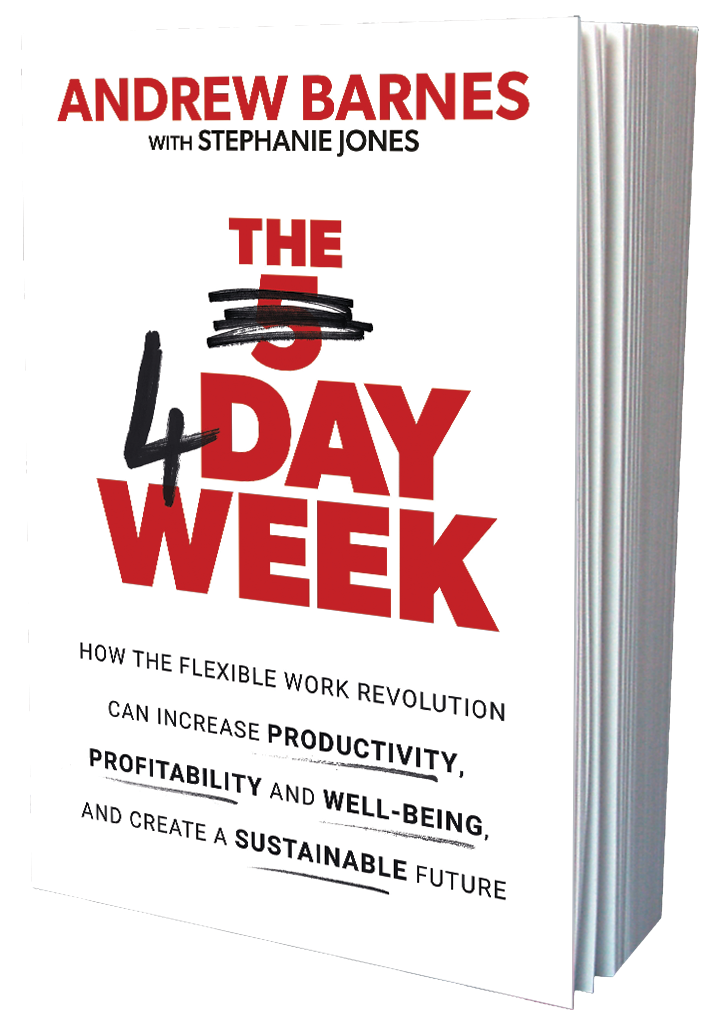Can we work better and deliver as much value in less time? For me, the answer is obvious. As everyone seeks to better balance their personal and professional lives, time becomes the most critical resource. Succeeding with the 4-day week is a serious asset for companies that want to attract and retain the best teams.

I was delighted to see that an entrepreneur had dared and succeeded in implementing this practice. Andrew Barnes explains it in his book written with Stephanie Jones. I share with you what you need to know.
The majority of us still go to a factory or a client’s site, and perform our tasks on a fixed schedule. But for knowledge workers, work is less and less associated with a place and a time.
How are we working at the moment?

Regular studies focus on productive time in organizations. In 2019, Vouchercloud surveyed nearly 2,000 full-time employees in the UK. On average, productive time was 2 hours and 53 minutes per day (out of 8 office hours). In 2022, Zippia obtained an average of 4 hours 12 minutes of work per day with a survey of 1,000 full-time US employees. Whatever the exact figure, it is certain that no one is effective 8 hours a day. Adding the travel time, we spend most of our day away from home.
The “gig economy” offers significant work flexibility in theory Everyone can decide when and how to work. But after a few years, we now know that it is not so , that it has above all made the workforce more precarious and set back the achievements of labor law.
The concept of the 4-day week paid 5

Andrew Barnes decided to do better and offer a win-win solution. His idea was simple: I want happy and productive teams. I offer you one day a week to do whatever you want, in exchange, you do the same job.
This approach is pragmatic, it takes into account the knowledge we have about how we spend our days. The request to the teams is simple: it is a question of working instead of going on social networks, reading the news or chatting with colleagues about non-job related topics. Everyone recovers the time thus saved and uses it as they see fit: reading social media at home, chatting with office colleagues in a bar or spending more time with their family, playing sports…
A simple and bold idea, but difficult to implement. Indeed, it only takes a few individuals for the change not to take place. We have a well-established paradigm that dates back over 100 years and promotes the 8 hours work, 8 hours leisure and 8 hours rest model. If this model improved the conditions of our ancestors, it no longer applies in 2022.
So what are the keys to the success of the 4-day week?
Building Trust
For this to work, you need to have a culture that fosters trust . The decision is made at the top, but the teams decide on the application. Each sector determines what works best for its reality. What changes in work organization are needed to make the concept work?
Keep it simple
100% of salary for 80% of the time and 100% of productivity. It can be the 4-day week, or reduced hours each day. I imagine it could also be one week off every 5 weeks or two months off (plus holidays) every year. Each company has its reality and its cycles.
Make a pilot or get started
Again, depending on your organization, a pilot to test or convince may be the best option. If your organization is already liberated or very Agile, don’t hesitate to jump right in.
Changing the Paradigm
There is a key concept to understand and change: the bottleneck is time , other resources are more abundant. How can we use our time better? Our society values being busy, being overwhelmed and working a lot. It is possible to be happy by working less.
Do your homework
Before you jump in and even talk about it, you should take a measure of the level of happiness or productivity. This is the best way to measure your progress. Then, take the time to validate the labor legislation, what can you do and how should you modify the employment contracts?
The 4-day week is above all a productivity objective. The happiness of teams and the balance of life are the consequences of productivity.
Managing highly productive individuals
This is in my opinion the biggest challenge. People who are already 100% productive, working all day non-stop. They don’t take breaks, don’t read social media on work time, and already struggle to do all their work in 8 hours a day.
When they share their fears with you, listen to them. Try to understand what causes their overwork. Is it a mental construction to respond to cultural imperatives? Indeed, it is quite frowned upon not to have lots of work to do.
If their work is already optimized, there are things that will no longer be done. You will have to choose which ones. These people may be victims of overprocessing, they may also have trouble aligning their actions with the company’s vision. In any case, you will have to accompany them and see what can be improved or stopped to save time. Beware, the time they save is not to do more, but to go home and live. If they can’t stop working and have nothing else to do, suggest them to volunteer. Many not-for-profit organizations need talented people.
Implement the 4-day week
This concept also applies in call centers, commerce and businesses where fixed hours exist. Of course, it will take more staff to cover the time slots, but ultimately, happier individuals will be less sick, make fewer mistakes, stay on the job longer and make more sales or satisfied customers. These gains, often overlooked , are significant.
John Maynard Keyness (economist 1883-1946) predicted in 1930 that in the future automation would cause humans to work only 15 hours a week. Do you want to try?
